Address any questions or comments regarding this newsletter to the individual authors listed after each article or to its editors, Nathan Johanning, 618-939-3434, njohann@illinois.edu or Bronwyn Aly 618-695-6060, baly@illinois.edu. The Illinois Fruit and Vegetable News is available on the web at: http://ipm.illinois.edu/ifvn/. To receive or be removed from email notification of new postings of this newsletter, contact Nathan Johanning or Bronwyn Aly at the phone numbers or email addresses above.
In This Issue:
Upcoming Programs (listings for beginning and established growers)
Regional Reports (west central Illinois, St. Louis Metro East, southern Illinois, Dixon Springs)
Upcoming Programs
See the University of Illinois Extension Local Food Systems and Small Farms Team’s website at:
http://web.extension.illinois.edu/smallfarm/ and the calendar of events at http://web.extension.illinois.edu/units/calendar.cfm?UnitID=629.
- Twilight Field Day at Huyck Farms, Tuesday October 29, 2019, 5 p.m. 3005 Cairo Road Paducah, KY 42001. This program will cover the basics of cole crop production and a tour of a colored cauliflower variety demonstration trial. For more information contact Kathryn Wimberley at the McCracken Co. Extension Service at 270-554-9520.
- Homegrown Blueberries and Health Benefits Webinar: Wednesday October 23, 2019 at 11:00 a.m.
Join us in a 90-minute webinar on blueberry growing, health benefits and preservation of blueberries at home. University of Illinois educators Drusilla Banks (Nutrition & Wellness) and James Theuri (Local Food Systems/Small Farms) will deliver the presentation. Information on growing tips, protection from insect pests, health benefits, cooking, freezing, canning, and drying information. May offer tips you could share with customers on different uses and preserving berries from your farming operations.
Event is free, but registration by October 21 is necessary for you to receive the meeting link. Register here: https://extension.illinois.edu/gkw For more information, email James Theuri: jtheu50@illinois.edu , or call 815.933.8337
- 2020 Illinois Specialty Crops Conference, January 8-10, 2020, Springfield, IL. Save the date!!!! https://www.specialtygrowers.org/2020-save-the-date . More information to follow later in the year but mark your calendars now and plan on attending the pre-conference workshops, conference programming, trade show, and annual association meetings!
- 2020 Southwest Illinois Commercial Tree Fruit School, Tuesday, February 4, 2020 at the Knights of Columbus Hall just south of Hardin, IL. Save the date and more information to follow!
- 2020 Southern Illinois Fruit and Vegetable School, Wednesday, February 5, 2020, Mt Vernon Doubletree Inn. This program includes separate tracks for small fruit, tree fruit and vegetable production. Save the date and more information to follow!
Regional Reports
From the St. Louis Metro East… Cooler weather has finally arrived and with it a much anticipated forecast of rain. Since September 1, much of the region has only received 0.50” of rain. It’s only been the last week that we have dropped out of the 90s for highs each day. Horseradish and sweet potato digging has had some delays due to dry soil causing root breakage. Vegetable crop also still in harvest include green beans, collards, mustard greens and turnip greens. Hard to believe, but apple harvest is approaching the final stages. Fuji and Granny Smith are in current harvest, along with what is left of Sungold, Braeburn and Winesap. The pumpkin crop is still looking great.
Elizabeth Wahle (618-344-4230; wahle@illinois.edu)
From west central Illinois… What a year! I think most folks would like to see the conclusion of 2019, and I’m one of them. Except for the dry spell we had from early July to mid-August, we’ve been getting tremendous rains. I don’t know how many times the terraces have topped this year, but the last time was Sept. 28th, when the rains even topped our lane, which has never happened.
We’ve not really had to irrigate the plasticulture strawberries much with the constant rains. The plants look excellent, and we’re almost through the first runner pruning. We cut way back on the number of plants this year mainly due to the inability to find help picking them. And the fact that we’re getting older J.
We’re still picking tomatoes from one tunnel, the other has been planted into spinach. The tomato plants were planted the first week in April, and don’t look very good, but they’re still putting out tomatoes, which are still somewhat easy to sell. The fruit is definitely smaller, and the plants are suffering from spider mite issues (I wasn’t going to treat when only a few weeks remained of the season).
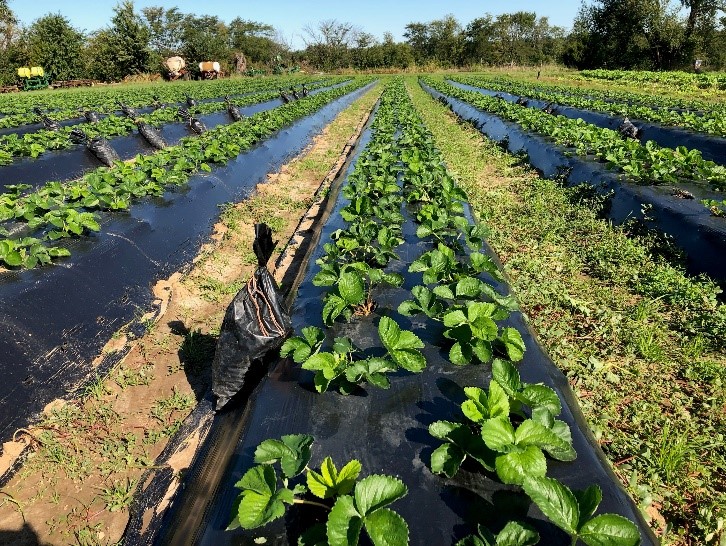
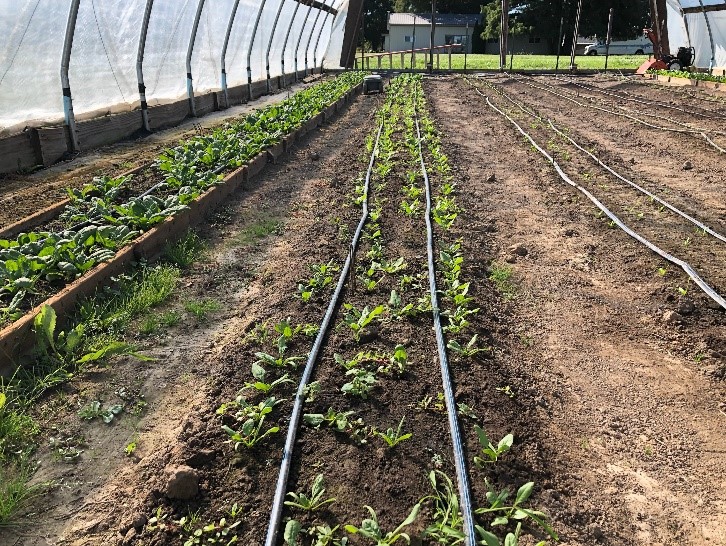
Heavy rains before rye seeding took hold washed soil off shoulders of raised beds for plasticulture strawberries (left). Several seedings of spinach in various stages of growth in a high tunnel. Photos: M. Roegge
The other tunnel had the tomatoes removed in August and I just finished planting the last row of spinach, so these last few rows probably won’t get picked until next spring. But the taste of winter spinach just can’t be beat, as the plant produces higher amount of sucrose to withstand freezing temperatures. We sell to a local restaurant and eat spinach salad quite often during the winter.
The asparagus plants look great, as we treated for cercospora starting in early August, every two weeks alternating with Bravo and mancozeb. Plants are dark green and have great growth. The spring rains really hurt one field that is wetter than the others, in fact we quit picking it early to prevent too much stress. The plants are definitely smaller and the new plants (two years old) in that field didn’t put out a lot of growth. This same field had a little over an acre of sweet corn that we didn’t harvest 100 dozen from, just too many drowned out spots due to the constant rains.
Another asparagus field we have is located north of a subdivision where a lot of maple trees are in back yards. I think every maple seed this spring must have grown a tree and there are thousands of seedlings in that asparagus field. I still haven’t figured out an effective control strategy for those volunteer trees, other than hand treat (which in my mind isn’t very efficient).
The sweet corn crop this year was really stressed as well, due to wet soils. A few fields had weed issues and/or nitrogen loss as well as reduced plant stands due to excessively wet soils. We had a few gaps as well because we just couldn’t plant when we needed to.
We had the best onion crop ever this year, with a higher percent of large bulbs. I’m guessing I haven’t been irrigating enough so I’ll make note of that for future years.
Last year we had a 75% loss of pumpkin due to a wet September and fruit rots. But because there was such a great set, we didn’t run out. This year we’re also seeing quite a few rotten fruits, again due to wet September (4.7” rain). I’m hoping that the rot won’t be as severe as last year, but we’re continuing to receive rain (.72” in October as of 10/7). Our first planting of pumpkins was lost due to rains, and we replanted on June 26th, which is later than we’ve ever planted, but we do have a decent number of fruit, it’s that there are so many with rot. The area is short of pumpkins this year. The wet spring prevented many from planting or planting as much as they normally would, and the wet fall is not helping either.
Mike Roegge, Retired Extension Educator & Mill Creek Farms (roeggem@illinois.edu)
From southern Illinois... We have finally gotten a break from the summer time heat and have had more “normal” fall temperatures with highs in the 70s and 80s. We had some rain last Sunday (10/6) only amounting to about a quarter inch here in Murphysboro. I heard reports of closer to 0.6” in Union County. Overall it is still very dry. We have good rain chances the end of this week with a major cool down. This upcoming weekend highs are supposed to be hopefully up to the 60s and lows in the low 40s and maybe even some upper 30s. So far there is not any prediction of frost, but we could be very close to it.
Apple harvest is slowing down, getting to the end of the season. Many fall plantings of vegetables have appreciated the break from the summerlike heat. Pumpkin harvest continues and we are right in the middle of some of the peak marketing season for pumpkins with many fall festivals. At my office in Murphysboro we just harvested a nitrogen rate and placement trail. The results look very promising, from first observation of the data. Plan to attend the pumpkins preconference workshop at Springfield in January to hear more about this trial!
Refering back to the article on cowpeas as a cover crop, I mentioned mowing as a good termination too. Well with them lodged and laid over it set them back, but they bounced back more than what I anticipated (see the picture). This isn’t really all together bad at all. My main goal in “terminating” with mowing was to prevent seed production and I effectly accomplished that. The regrowth will continue to benefit the soil and continue to suppress any winter annual eds. Cowpeas are a summer annual and very frost sensitive so their days are numbered and the first frost/freeze will take care of any regrowth.
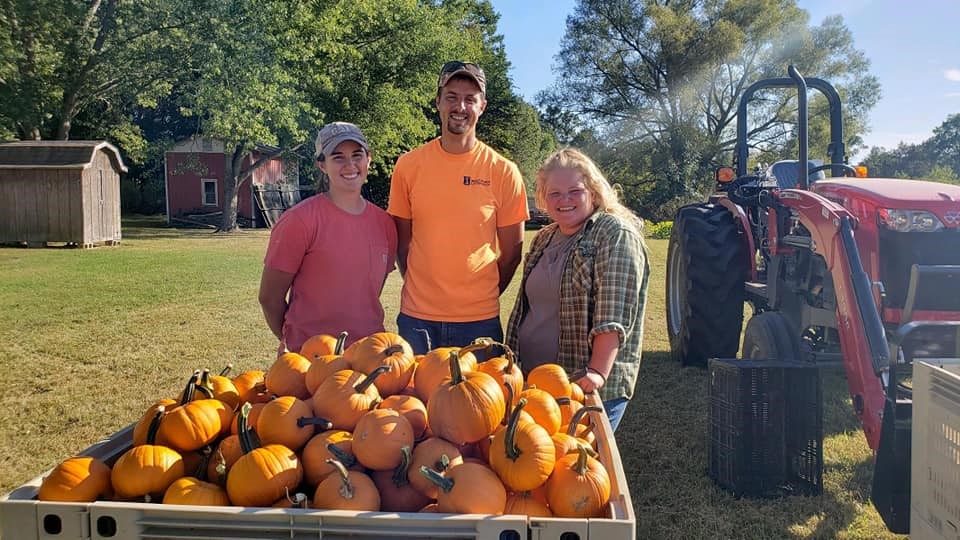
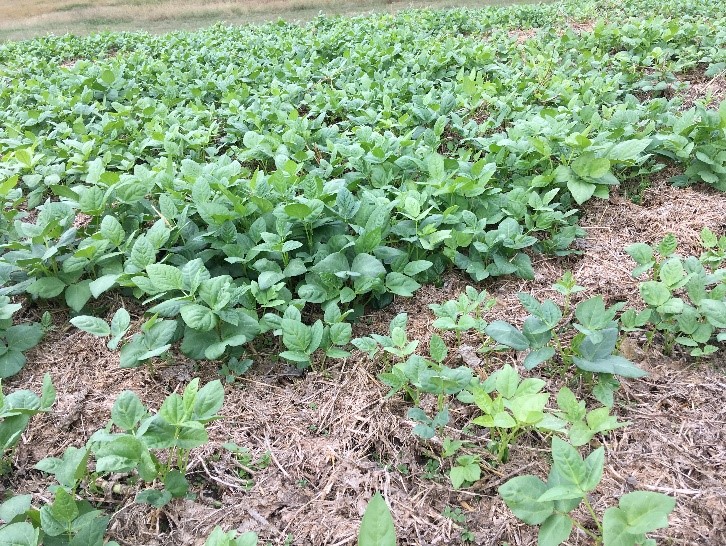
Taylor Sloop, Nathan Johanning and Maggie Ray harvesting the pumpkin nitrogen trial at the Jackson County Extension Office (left). Photo: L. Heins. Cowpea regrowth after mowing (right). Photo: N. Johanning.
Nathan Johanning (618-939-3434; njohann@illinois.edu)
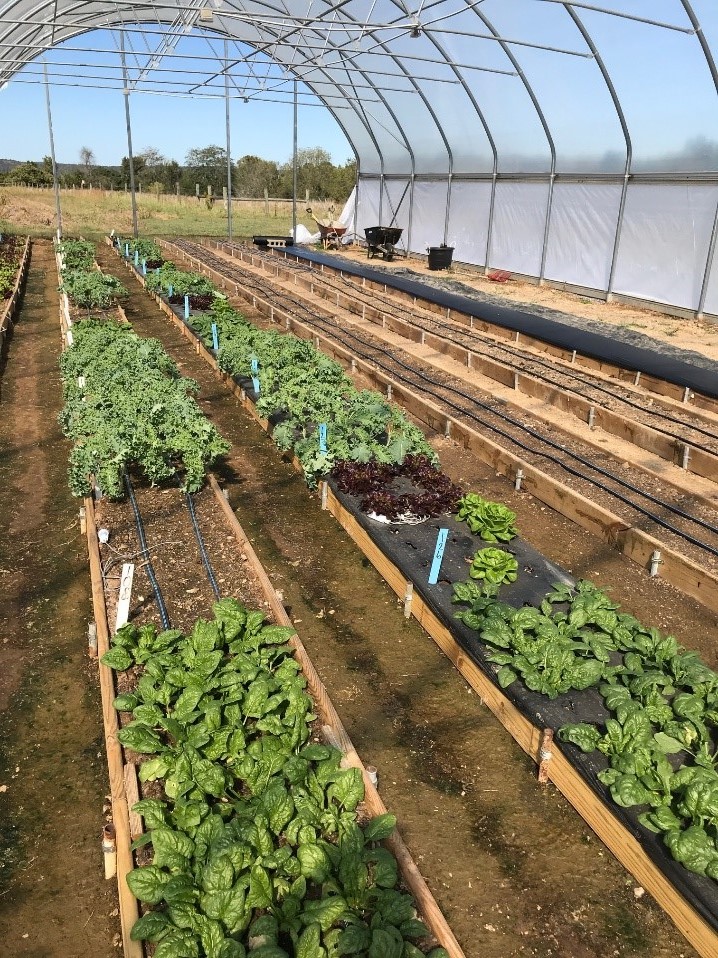
From Dixon Springs Ag Center…We have harvested lettuce, kale and spinach from the early September planting date as well as carrots from the early August planting date for the first round of data collection in our high tunnel winter production project. Kale and spinach will continue to be harvested once or twice per week from this planting date, and we made the second planting (early October planting) on Wednesday of this week. Insect pests that have been observed on these crops include mainly cabbage worm, army worm, aphids, and flea beetles. Also noticing a few cucumber beetles as well.
Fruit production in the pepper plots is basically complete but there are still several good quality tomatoes being harvested. Tomato fruit size and flavor is still very nice. Golden beets and sugar snap peas in the youth tunnel have grown well and are ready for harvest.
Lettuce, kale and spinach plots between first and second harvest in high tunnel at DSAC. Photo by B. Aly.
As we have quickly transitioned from summer to a potential frost, we are working diligently to get the winter production tunnel buttoned up and ready for possible crop protection over upcoming weekend. I believe we may have experienced a whole 7 days of fall. Also, our four legged venison friends discovered that they like lettuce, spinach, and carrot tops, hence the even more immediate need to get the end walls and side curtains in place. Until this week, these cool season fall/winter crops have appreciated the openness of the tunnel during our run of 90+ degree days over the past several weeks.
It got a bit breezy yesterday afternoon, and you can probably guess from the photo that we had some fun getting the left side curtain locked into the track on the baseboard. But never fear, our combined (Julie and Bronwyn) stubbornness won and the curtain was anchored down nicely by the end of the day.
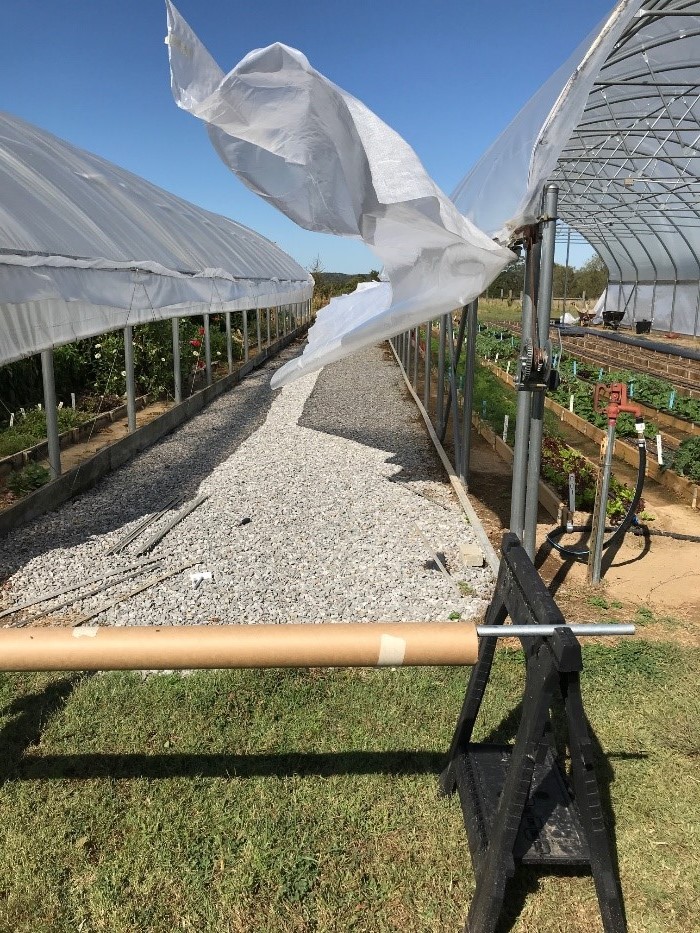
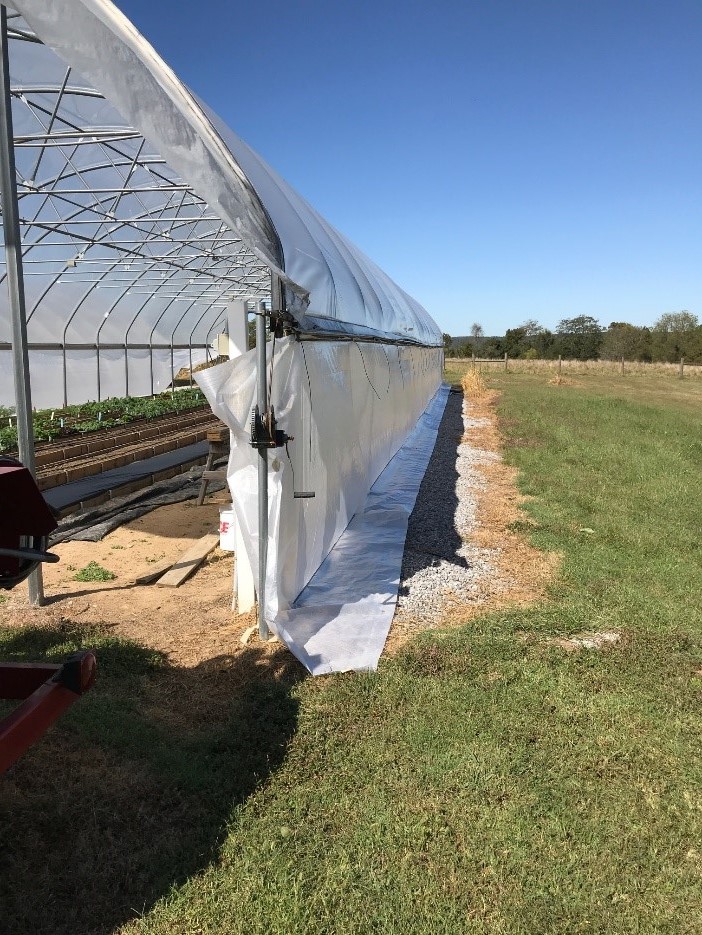
Side curtains being installed on a windy October day on the Stuppy brand high tunnel at DSAC. This side curtain system, a drop down curtain, uses metal strips rolled into track instead of wiggle wire to secure the top and bottom of the curtain. The top of the side curtain is attached to a track that is part of a metal rail system that is lowered using a crank. The bottom of the side curtain is attached to track that is part of the baseboard. The photo on the left was taken after the curtain was attached to the top rail but before the bottom could be secured into the baseboard track. The photo on the right shows the completed side – which was installed quite easily before the wind decided to kick up a bit. Photos by B. Aly.
Bronwyn Aly (618-382-2662; baly@illinois.edu)
Less Seriously
For those 4-Hers (past, present, or parents of) who read this newsletter, in recognition of National 4-H Week, thought we would share a photo of a Mt. Gem tomato grown in the 4-H youth high tunnel at DSAC and harvested on October 4th. It was absolutely perfect, with even ripening and just a hint of a crack near the scar to give the homegrown in your back yard feel.
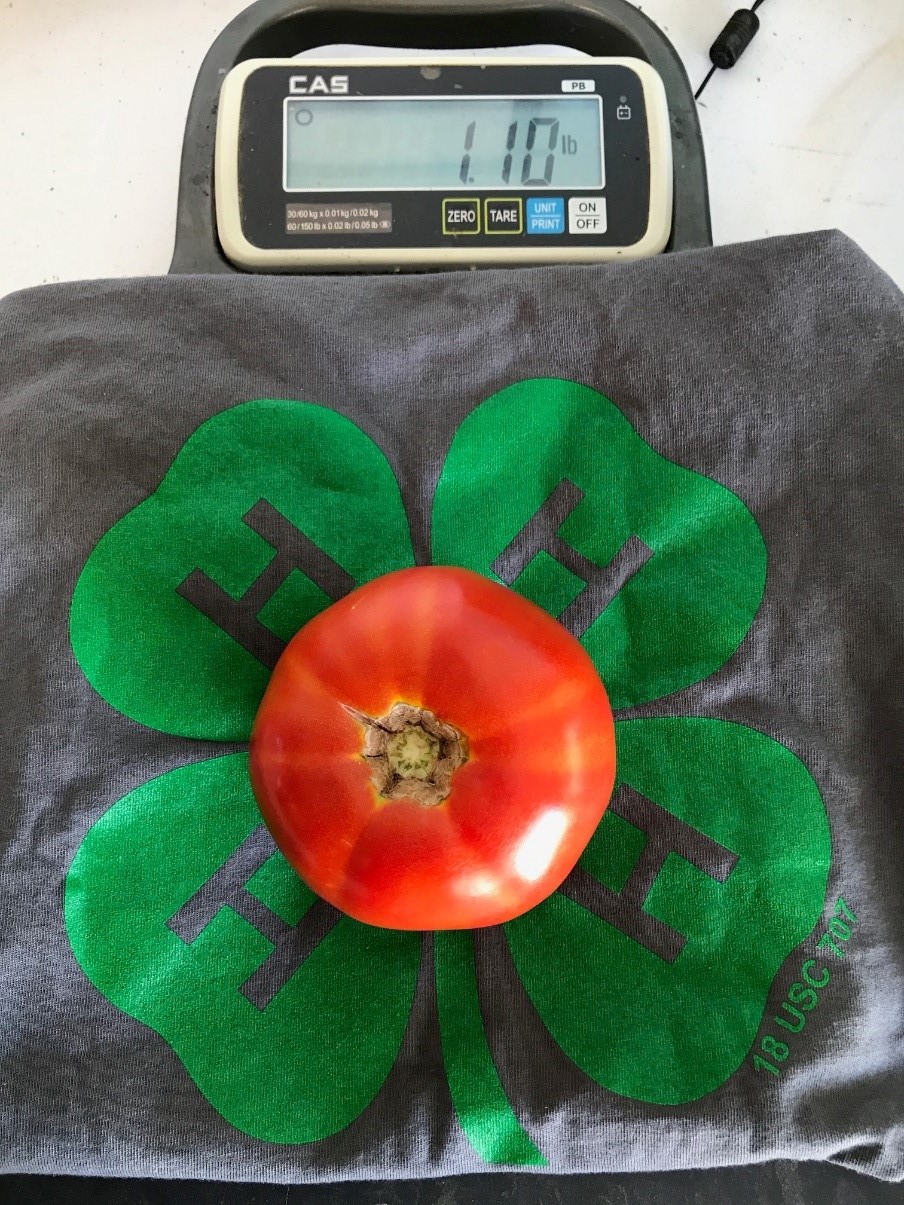
University of Illinois Extension Specialists in Fruit and Vegetable Production & Pest Management
Extension Educators – Local Food Systems and Small Farms |
||
Bronwyn Aly, Gallatin, Hamilton, Hardin, Pope, Saline, and White counties |
618-382-2662 |
|
Katie Bell, Franklin, Jackson, Perry, Randolph, & Williamson counties |
618-687-1727 |
|
Sarah Farley, Lake & McHenry counties |
847-223-8627 |
|
Nick Frillman, Woodford, Livingston, & McLean counties |
309-663-8306 |
|
Laurie George, Bond, Clinton, Jefferson, Marion, & Washington counties |
618-548-1446 |
|
Zachary Grant, Cook County | 708-679-6889 | |
Doug Gucker, DeWitt, Macon, and Piatt counties |
217-877-6042 |
|
Erin Harper, Champaign, Ford, Iroquois, and Vermillion counties |
217-333-7672 |
|
Grace Margherio, Jackie Joyner-Kersee Center, St. Clair County |
217-244-3547 |
|
Grant McCarty, Jo Daviess, Stephenson, and Winnebago counties |
815-235-4125 |
|
Katie Parker, Adams, Brown, Hancock, Pike and Schuyler counties |
217-223-8380 |
|
Kathryn Pereira, Cook County |
773-233-2900 |
|
James Theuri, Grundy, Kankakee, and Will counties |
815-933-8337 |
|
Extension Educators – Horticulture |
||
Chris Enroth, Henderson, Knox, McDonough, and Warren counties |
309-837-3939 |
|
Richard Hentschel, DuPage, Kane, and Kendall counties |
630-584-6166 |
|
Andrew Holsinger, Christian, Jersey, Macoupin, & Montgomery counties |
217-532-3941 |
|
Extension Educators - Commercial Agriculture |
||
Elizabeth Wahle, Fruit & Vegetable Production |
618-344-4230 |
|
Nathan Johanning, Madison, Monroe & St. Clair counties |
618-939-3434 |
|
Campus-based Extension Specialists |
||
Kacie Athey, Entomology |
217-244-9916 |
|
Mohammad Babadoost, Plant Pathology |
217-333-1523 |
|